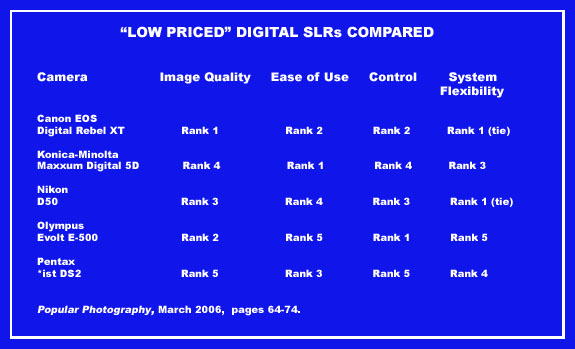"BUDGET" DIGITAL SLRs COMPAREDThe March 2006 issue of Popular Photography (pages 64-74) has another “Shoot-Out”. This one is between the low-priced digital SLRs with 6 to 8 megapixel sensors. “Low priced” is a relative term since digital cameras are more expensive than film cameras. The “street price” for these cameras (body only) ranges from a low of $570 to a high of $790. At least in D-SLR terms, these are the budget models.
I have generally found the assessments in Pop Photo to be reliable. A summary of the major finding in the article are in the following table.

Pop Photo puts the cameras through a series of tests to determine the overall Image Quality. Ease of Use should be self explanatory. Control refers to how many controls the camera gives you over the image making process (not how easy those controls are to access). System Flexibility refers to the number of lenses and accessories that are available to use with the camera.
Other items compared in the article are resolution, color acuracy, noise, image quality at different ISOs, autofocus speed, and CIPA batttery rating. I recommend you read all of the details in the original article.
Before making any choices, remember that lenses are more important than camera bodies. Lenses should last a long, long time. camera bodies (especially digital) get replaced. Years of teaching photography and looking at student work reinforces a valuable message about quality: A photographer's sense of vision along with proper photgraphic technique has the biggest impact on image quality. Lens quality comes in second. Camera bodies are a distant third.
I have had a few students where a substandard camera was holding them back - but not very many. More students suffered from using el-cheapo, bizarre-brand lenses and needed to spend a modest amount of money to get a good lens. On the other hand, good technique with good quality equipment beats out great equipment and poor technique any day of the week.
If you already have a film SLR and are thinking of getting a “budget” digital SLR, your first thought should be about the number and quality of the lenses you already have and whether or not they will work on a digital SLR. If you have several lenses and you are happy with them, you should consider getting a D-SLR that will take the lenses you already have. All of these cameras will take good quality pictures even though some have an image quality edge. Even if the body your lenses will fit isn’t ranked as high as you would like, an improved quality camera will come out in the future (PROVIDED your manufacturer stays in business).
If, like many photographers, you will only want a few lenses for your D-SLR, the choice of brand isn’t so important. If you will need specialty lenses (i.e. image stabilization, vibration reduction, macro, tilt-shift), then the brand and selection becomes more important. Nikon and Canon have the most complete systems with the most flexibility. I use a number of specialized lenses for a variety of projects, and only Canon makes all of the specialized lenses that I need. Having said that, most manufacturers make enough lenses to keep most photographers happy.
What if you don’t have any SLR lenses now, or you have some lenses but you aren’t happy with the total selection of lenses available from your manufacturer? In either case, camera quality and features as well as the total system of lenses available in a particular brand becomes more important. You should read the Pop Photo article carefully to compare features along with the camera reviews at DP Review and other review sites listed on my LINKS page. Pick a camera with the features you want that has a lens system that is adequate for your present and future needs.
I have a comparison of mid-priced digital SLRs here.